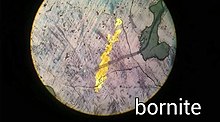Bornite
| Bornite | |
|---|---|
 Lightly iridescent bornite crystal on quartz needles, from Kazakhstan Specimen size: 3.6 cm × 2.2 cm × 1.2 cm (1.42 in × 0.87 in × 0.47 in) | |
| General | |
| Category | Sulfide mineral |
| Formula (repeating unit) | Cu5FeS4 |
| IMA symbol | Bn[1] |
| Strunz classification | 2.BA.10 |
| Crystal system | Orthorhombic |
| Crystal class | Dipyramidal (mmm) H-M symbol:(2/m 2/m 2/m) |
| Space group | Pbca |
| Unit cell | a = 10.95 Å, b = 21.862 Å, c = 10.95 Å; Z = 16 |
| Identification | |
| Formula mass | 501.88 g/mol |
| Color | Copper red, bronze brown, purple |
| Crystal habit | Granular, massive, disseminated – Crystals pseudocubic, dodecahedral, octahedral |
| Twinning | Penetration twins on [111] |
| Cleavage | Poor on [111] |
| Fracture | Uneven to subconchoidal |
| Tenacity | Brittle |
| Mohs scalehardness | 3–3.25 |
| Luster | Metallic if fresh,iridescenttarnish |
| Streak | Grayish black |
| Specific gravity | 5.06–5.08 |
| Refractive index | Opaque |
| Pleochroism | Weak but noticeable |
| Other characteristics | Magnetic after heating, iridescent |
| References | [2][3][4] |
Bornite,also known aspeacock ore,is asulfide mineralwithchemical compositionCu5FeS4thatcrystallizesin theorthorhombic system(pseudo-cubic).
Appearance[edit]

Bornite has a brown to copper-red color on fresh surfaces that tarnishes to variousiridescentshades of blue to purple in places. Its striking iridescence gives it the nicknamepeacock copperorpeacock ore.
Mineralogy[edit]
Bornite is an important copper ore mineral and occurs widely inporphyry copper depositsalong with the more commonchalcopyrite.Chalcopyrite and bornite are both typically replaced bychalcociteandcovellitein thesupergeneenrichment zone of copper deposits. Bornite is also found as disseminations inmaficigneous rocks,incontact metamorphicskarndeposits, inpegmatitesand insedimentarycupriferousshales.[3]It is important as anorefor itscoppercontent of about 63 percent by mass.[2]
Structure[edit]

At temperatures above 228 °C (442 °F), the structure isisometricwith a unit cell that is about 5.50 Å on an edge. This structure is based on cubic close-packedsulfuratoms, with copper and iron atoms randomly distributed into six of the eighttetrahedralsites located in the octants of the cube. With cooling, the Fe and Cu become ordered, so that 5.5 Å subcells in which all eight tetrahedral sites are filled alternate with subcells in which only four of the tetrahedral sites are filled; symmetry is reduced toorthorhombic.[5]
Composition[edit]
Substantial variation in the relative amounts of copper and iron is possible andsolid solutionextends towards chalcopyrite (CuFeS2) anddigenite(Cu9S5). Exsolution of blebs andlamellaeof chalcopyrite, digenite, and chalcocite is common.[5]
Form and twinning[edit]
Rare crystals are approximately cubic,dodecahedral,oroctahedral.Usually massive. Penetration twinning on thecrystallographic direction,{111}.[5]
Occurrence[edit]

It occurs globally in copper ores with notable crystal localities inButte, Montanaand atBristol, Connecticutin the U.S. It is also collected from the Carn Brea mine,Illogan,and elsewhere inCornwall,England. Large crystals are found from theFrossnitz Alps,easternTirol,Austria; the Mangula mine,Lomagundi district,Zimbabwe; from the N'ouva mine,Talate,Morocco, the West Coast of Tasmania and inDzhezkazgan,Kazakhstan.[3]There are also traces of it found amongst thehematitein thePilbararegion ofWestern Australia.
History and etymology[edit]
It was first described in 1725 for an occurrence in theOre Mountains,Bohemia,in what is now theKarlovy Vary Regionof the Czech Republic. It was named in 1845 for Austrian mineralogistIgnaz von Born.[4]
See also[edit]
References[edit]
- ^Warr, L.N. (2021)."IMA–CNMNC approved mineral symbols".Mineralogical Magazine.85(3): 291–320.Bibcode:2021MinM...85..291W.doi:10.1180/mgm.2021.43.S2CID235729616.
- ^abBarthelmy, David (2014)."Bornite Mineral Data".Webmineral.com.Retrieved12 August2022.
- ^abcAnthony, John W.; Bideaux, Richard A.; Bladh, Kenneth W.; Nichols, Monte C. (2005)."Bornite"(PDF).Handbook of Mineralogy.Mineral Data Publishing.Retrieved12 August2022.
- ^abBornite,Mindat.org,retrieved12 August2022
- ^abcNesse, William D., "Sulfides and Related Minerals" inIntroduction to Mineralogy,New York: Oxford University Press, 2000, p 429
Bibliography[edit]
- Palache,C., H. Berman, and C. Frondel (1944)Dana’s system of mineralogy,(7th edition), v. I, 195–197.
- Manning, P.G. (1966)A study of the bonding Properties of Sulphur in Bornite,The Canadian Mineralogist, 9, 85-94
